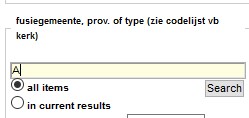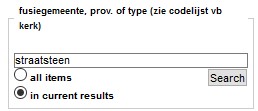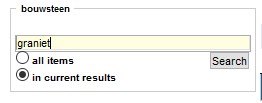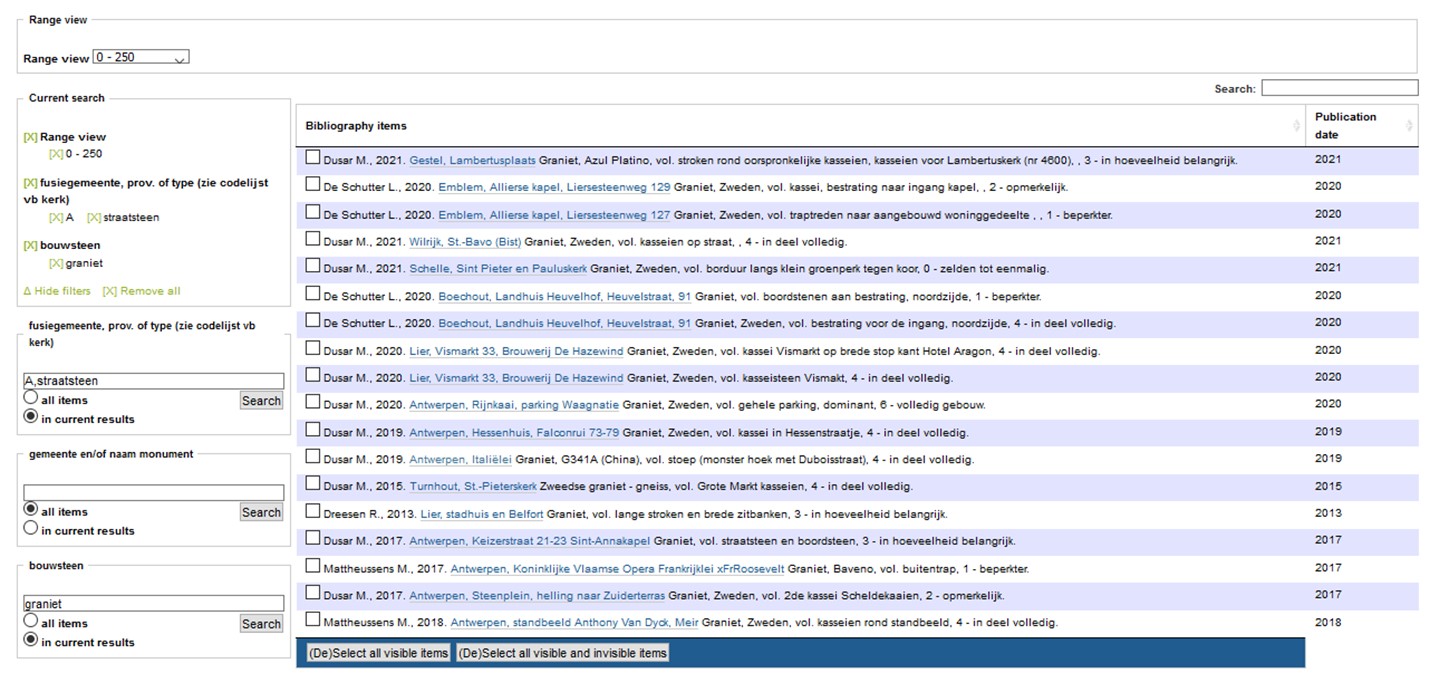Database ‘Natural Building stone in monuments'
|
Introduction |
|
The database made available here is part of a larger whole of natural stone inventorisation by the Geological Survey of Belgium - RBINS. This website is a representation of the access database which has been maintained as a work in progress for quite some time. In addition to this access database, the GSB has an extensive photo library of the monuments, a collection of natural stones from monuments and quarry samples, archival documents such as the manuscripts of Carl Camerman and the natural stone files of Paul Dumon, and some specific collections such as the 1897 expo collection and the Horta collection. In addition, the Geological Survey of Belgium has developed a bibliographic database on the geology of Belgium in access with keyword and geological map search functions, linked to the pdf of the articles concerned (when available or accessible). Currently this contains more than 2000 natural stone references. |
|
Use |
|
The use of the digitally shared database is free provided that the source is acknowledged: name of institution, year, title of database, internet address, date of consultation. We are not responsible for any problems or errors resulting from the use of this database. |
|
Manual |
|
The information of the different monuments are available through different tabs by letter, including all buildings within the municipalities starting with the letter of the chosen tab. The information is available in a table indicating the following items : Municipality = amalgamated municipality Name monument = (amalgamated) municipality and name of the building Type of building = indication regarding the type of building Period = main period during which the building was constructed. These periods can be arranged chronologically through the number in front of the name. Name of the building stone = the specific building stone utilized Name of the building stone variety = in some cases it can be useful to also mention the specific variety when known Part of building where the stone is used = indication in which part of the building the stone was utilized Quantity = indication regarding the quantity of this stone in relation to the building. A code list is also used for this. Since this field was added later, this field was not always used. The table can be sorted according to any field by a simple click on the column title. A search function is present at the top right of the table, so that specific items are also shown in the table, for example a certain type of stone. Different terms can be entered one after the other. For example, Ledesteen portal to get a list of all monuments where ledesteen has been used in the portal. Drawbacks of this system : Work is done by letter of the municipality rather than on the entire database. There is no possibility to export the table
2. Version https://collections.naturalsciences.be/ssh-geology-bibliography/geology/monuments This version is going to treat the data as bibliographic references. The big advantage is that all selections are done on the entire database, and the table can also be exported. At the top is a link to the code lists used. Then there is the left column with a number of options for querying the table. The first choice to make is the number of results you want to display. The default range is 250 records. This is useful to limit the search time. If you want the entire contents of the database you can change this range to "All", but that will certainly slow down the display of the results. If you are satisfied with only the first 250 in your result you can press search without filling in any of the search fields. Of course, it is better to do a targeted search. The first possibility is to enter a municipality, province or type. The codes used for the provinces and types can be found in the code lists. For example, if you are looking within the province of Antwerp, then you enter a capital "A" in the search field. And then you press the Search button.
If you only want to see the paving stones within the province of Antwerp in your results, then fill in 'straatsteen' (see code list) and tick the option 'in current results'.
The result is a list of all identified paving stones within the province of Antwerp. You can now go on to select under the building stone heading to get only granite in the search result. Don't forget to check the box that says you want to search in the current search results.
In the top left is a summary of your choice. You can also adjust your choice there by removing search criteria.
The result on the right is a table with author and date of the sighting - if filled in - then with a hyperlink the name of the monument consisting of municipality and building, and then a number of characteristics such as the type of stone, its location and quantity. A click on the link will take you to an additional page with possibly some more details. Search result overview
Example of a detail page
The result can be saved via the excel export. Do not forget to select the requested data before exporting the data. The selection list is available on the following page : https://collections.naturalsciences.be/ssh-geology-bibliography/geology/monuments/keywords-natural-building-stone |
|
|
|
History |
|
This access database finds its origin in the systematic inventory of monuments for the Natuursteenatlas Limburg*. The preparation of that book included a then rather limited list of the natural stone in the buildings of Limburg and that in a georeferenced access database, so that distribution maps could be made. After finishing the book, the feeling remained that there was still much more to do in this area. Roland Dreesen took several initiatives in the following years to start up projects to extend this work to the whole of Flanders, unfortunately this did not succeed at the time. In 2005, Marian Niclaes was recruited by the GSB to collect and bundle the knowledge on natural stone of the experts, including Eric Groessens. During that year, but especially from 2006 onwards, the geological inventory in the access database was further developed by Michiel Dusar, who retained the coordination, based on his own observations, supplemented by reliable geological information from colleagues and scientific collaborators. In the following years, Marleen De Ceukelaire became a partner in the inventory and acted as manager of the databases and collections and of the websites derived from them. Several fields were added over time and every opportunity to supplement data was taken. Information sources were both occasional observations and research projects. With increasing insight, the expertise was gradually extended in order to arrive at a representative picture of natural stone use in Flanders and Brussels. To this end, the inventory was extended geographically, focusing on Belgium north of Sambre and Meuse and the adjacent Dutch provinces. Over the last few years, the database has grown by about 20000 records per year of more than 4000 buildings. The results can be consulted on this website and are regularly updated. However, this website cannot make all elements of the access database publicly available. The geological data compiled in this database remains the intellectual property of the Belgian Geological Service and of the respective authors. If you want more information and want to use the underlying database or the related information sources of the Belgian Geological Service, please contact the administrator at mdeceukelaire@naturalsciences.be. *Dreesen, R. & Dusar, M. & Doperé, F., 2001. Atlas Natuursteen in Limburgse monumenten. Provincie Limburg, 294 p. (nieuwe herwerkte uitgave in 2019) |
|
Mdc 2021/06/01 - translation Thomas Goovaerts |






